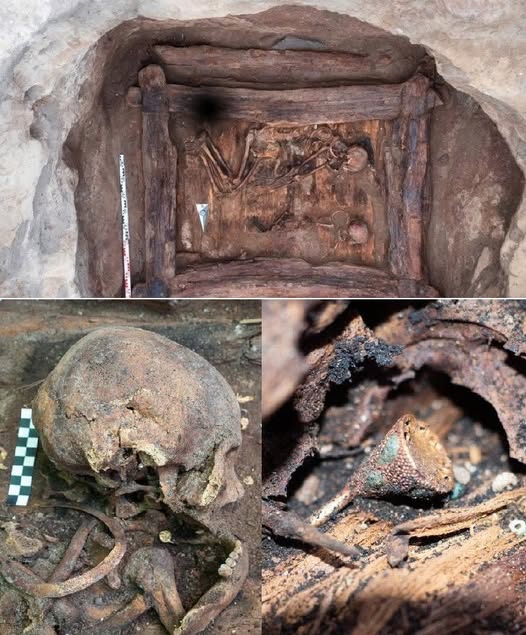The archaeological excavation in the Touran-Uyuk valley, Russia, has yielded a remarkable discovery, challenging traditional interpretations of Scythian society. The 2,500-year-old burial mound, associated with the Scythians, has revealed the remains of a woman adorned with invaluable artifacts, including a golden pectoral ornament typically reserved for male warriors, prompting a reassessment of gender roles in this ancient nomadic culture.
A Woman of Significance: Challenging Gender Norms:
The discovery of a golden pectoral ornament, usually associated with male warriors, alongside the woman’s remains, has sparked intrigue and debate.
An Unconventional Burial:
- The golden pectoral ornament, shaped like a sickle or crescent, is a striking find, as it is typically found in the graves of male Scythian warriors.
- Its presence in a woman’s burial suggests she held an unusual or elite position within Scythian society.
- This discovery challenges the long-held assumptions that Scythian women were confined to traditional domestic roles.
A Warrior or Leader?:
- Dr. Łukasz Oleszczak’s suggestion that the woman may have been a warrior or leader is supported by the presence of the golden pectoral ornament.
- This artifact, a symbol of martial prowess, indicates that she may have played a significant role in Scythian warfare or governance.
- The find opens new avenues for research into the potential for female leadership within the Scythian culture.
Rethinking Scythian Society:
- The discovery prompts a reevaluation of gender roles in Scythian society, suggesting a more complex and nuanced understanding of their social structure.
- It challenges the traditional view of a strictly patriarchal society, highlighting the potential for female agency and influence.
- This find promotes further exploration of the potential for female warriors, and the positions of power they held.
The Scythians: Nomadic Warriors of the Steppes:
The Scythians, who dominated the steppes for centuries, left behind a legacy of formidable warriors and intricate burial customs.
A Powerful Nomadic Empire:
- The Scythians, who thrived from 800 BCE to 300 CE, ruled the vast steppes stretching from the Black Sea to China.
- Their reputation as skilled warriors and horsemen instilled fear and respect throughout the ancient world.
- Their control of vast territory, allowed for great wealth, and cultural exchange.
Intricate Burial Customs:
- The burial mound in the Touran-Uyuk valley provides valuable insights into Scythian funerary practices, including the elaborate adornment of the deceased.
- The presence of valuable artifacts, such as the golden pectoral ornament, reflects the importance of status and wealth in Scythian society.
- The complexity of their burial rituals, suggest a complex belief system.
A Legacy of Warfare:
- The Scythians were renowned for their military prowess, employing advanced weaponry and tactics.
- Their legacy as formidable warriors is evident in the numerous artifacts found in their burial mounds, including weapons, armor, and elaborate horse trappings.
- Their influence on military tactics, can still be studied today.
Unraveling the Mysteries of the Siberian Valley of Kings:
The discovery in the Touran-Uyuk valley raises new questions about the Scythians and their society.
The Roles of Women:
- The find forces us to reconsider the roles of women in Scythian society, challenging traditional assumptions about their limited influence.
- Further research is needed to fully understand the extent of female agency and power in this ancient nomadic culture.
- The finding of more female burials, will help to further understand the role of women.
Hierarchical Structures:
- The discovery sheds light on the hierarchical structures within Scythian society, highlighting the potential for elite individuals, regardless of gender.
- It raises questions about the criteria for social status and the ways in which power was distributed.
- The artifacts found in the burial, show the level of wealth, and status, that the woman held.
Future Discoveries:
- The vast Touran-Uyuk valley, often called the ‘Siberian Valley of the Kings,’ likely holds more secrets waiting to be unearthed.
- Future excavations may reveal further insights into the lives and roles of women in Scythian society.
- The continued exploration of the valley, will help to unlock the secrets of this ancient culture.
The golden sickle of Tuva is more than just an archaeological artifact; it’s a powerful symbol of the evolving understanding of Scythian society. It challenges us to reconsider traditional narratives and embrace the complexity of ancient cultures.

CÁC TIN KHÁC
Mary Walton: The Forgotten Inventor Who Helped Clean Up America’s Cities
Tomb of Queen Nefertari in the Valley of the Queens, Egypt
Discover the Hypostyle Hall of the Temple of Hathor at Dendera
Venus de Losange: Unveiling the Mystery of a 20,000-Year-Old Paleolithic Icon